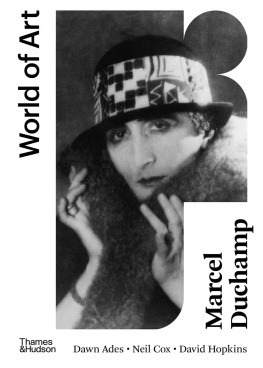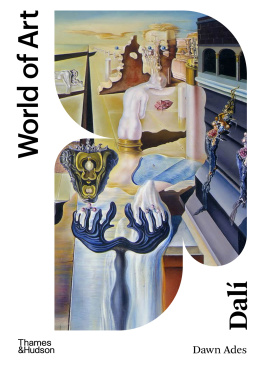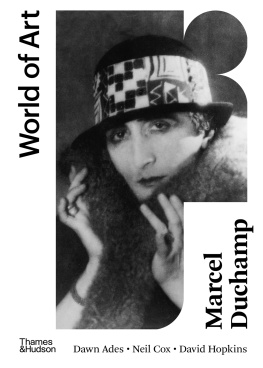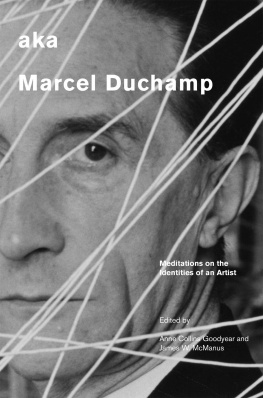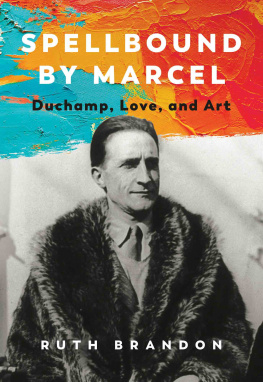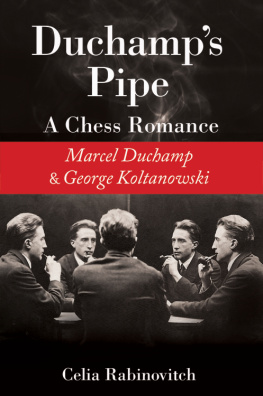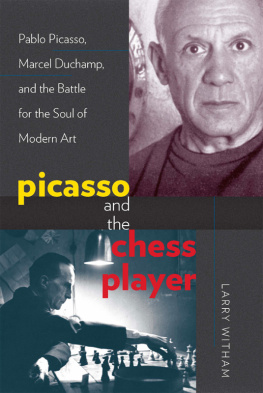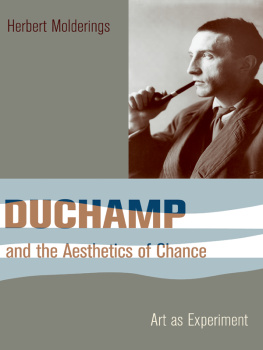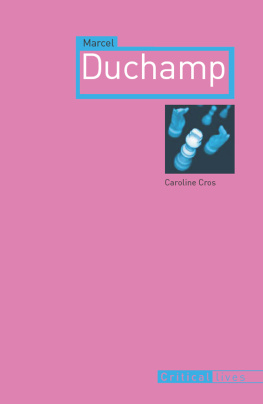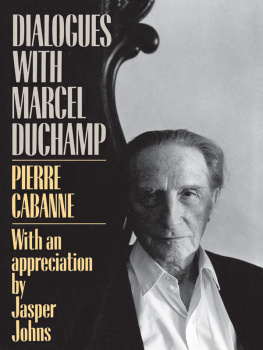Dawn Ades - Marcel Duchamp (World of Art), Second Edition
Here you can read online Dawn Ades - Marcel Duchamp (World of Art), Second Edition full text of the book (entire story) in english for free. Download pdf and epub, get meaning, cover and reviews about this ebook. year: 2021, publisher: Thames & Hudson, genre: Detective and thriller. Description of the work, (preface) as well as reviews are available. Best literature library LitArk.com created for fans of good reading and offers a wide selection of genres:
Romance novel
Science fiction
Adventure
Detective
Science
History
Home and family
Prose
Art
Politics
Computer
Non-fiction
Religion
Business
Children
Humor
Choose a favorite category and find really read worthwhile books. Enjoy immersion in the world of imagination, feel the emotions of the characters or learn something new for yourself, make an fascinating discovery.
- Book:Marcel Duchamp (World of Art), Second Edition
- Author:
- Publisher:Thames & Hudson
- Genre:
- Year:2021
- Rating:5 / 5
- Favourites:Add to favourites
- Your mark:
- 100
- 1
- 2
- 3
- 4
- 5
Marcel Duchamp (World of Art), Second Edition: summary, description and annotation
We offer to read an annotation, description, summary or preface (depends on what the author of the book "Marcel Duchamp (World of Art), Second Edition" wrote himself). If you haven't found the necessary information about the book — write in the comments, we will try to find it.
Marcel Duchamp (World of Art), Second Edition — read online for free the complete book (whole text) full work
Below is the text of the book, divided by pages. System saving the place of the last page read, allows you to conveniently read the book "Marcel Duchamp (World of Art), Second Edition" online for free, without having to search again every time where you left off. Put a bookmark, and you can go to the page where you finished reading at any time.
Font size:
Interval:
Bookmark:


Photograph of Duchamp using a hinged mirror (detail), 1917

Dawn Ades is Professor Emerita of the History and Theory of Art at the University of Essex. She has written extensively on Dada, Surrealism, photography and women artists, among other things. Publications include Dada and Surrealism Reviewed (1978), Photomontage (1986), Dal (1995) and Writings on Art and Anti-Art (2015). Among the exhibitions she has organized or co-organized are Art in Latin America (1989), Fetishism: Visualizing Power and Desire (1995), Salvador Dal: The Centenary Retrospective (2004), Undercover Surrealism (2006) and Dal/Duchamp (201718).
Neil Cox is Professor of Modern and Contemporary Art at the University of Edinburgh. His books include Cubism (2000) and The Picasso Book (2010), and he has written numerous essays connecting art and philosophical ideas, including on Braque and the philosopher Martin Heidegger, and on Richard Serras drawings in relation to Hegels aesthetics. In 2011 he curated an exhibition on modern still life at the Calouste Gulbenkian Museum, Lisbon, that included Duchamps readymades.
David Hopkins is Professor of Art History at the University of Glasgow. His books include Marcel Duchamp and Max Ernst: The Bride Shared (1998), Dadas Boys: Masculinity after Duchamp (2007), Virgin Microbe: Essays on Dada (co-edited with Michael White, 2014), A Companion to Dada and Surrealism (edited, 2016), After Modern Art 19452017 (2nd edition, 2018) and Dark Toys: Surrealism and the Culture of Childhood (2021).
Without the generous assistance and considerate advice of Madame Alexina (Teeny) Duchamp and of Jacqueline Matisse, her daughter, this book could not have been written. We owe them a great debt of gratitude, and dedicate this book to the memory of Teeny, who died in 1995. We would also like to thank Tamar Francis for her invaluable help at a critical moment.
Since this book was first published in 1999, research into Duchamps work has accelerated, as the volume of publications and exhibitions featuring his work testifies. One of the most notable features of this increase in attention is the picture that has increasingly emerged of Duchamp as a meticulous technician, and of his work as complex in nature. Much, in retrospect, was overlooked or taken for granted; that the precision of his ideas was matched by precision in the materials and their manipulation and construction is becoming clear. His reputation as the father of conceptual art for a time overshadowed his tinkering as an artist. Research has rewritten the history and process of construction of some of his most famous works, including 3 Standard Stoppages (191314), and at the same time thrown up numerous unexpected questions about the development of key works and concepts, such as that of the readymade.
Yet Duchamp remains a contested figure in art history, in contemporary art criticism and in wider cultural debates, argued over by curatorial luminaries such as Boris Groys and Okwui Enwezor, and often a point of departure in philosophical essays by writers including Alain Badiou and Slavoj iek. The question of Duchamps attitudes to gender identity, or his interest in the political, have become more prominent, while his work continues to be cited as the origin point of movements or strategies such as Conceptual Art or Institutional Critique. One criticism of Duchamp historians is that they treat him as an all-knowing genius, anticipating every move in advance, thus reinstituting the authority of the artist that his work was supposed definitively to undermine. That Duchamp can be treated as the father of many aspects of a critical avant-garde attitude does seem to undermine his challenges to the idea of the artist, or of the artists relationship to the work of art, missing the dissolution of meaning that they imply. In this book, however, we examine these connections as different critical responses to Duchamp; diverse reimaginings of and struggles with Duchamps work in modern and contemporary art. Such responses themselves often play upon and interrogate Duchamps ironic resistance to artistic intention, but also trade on its essential complement: radical openness to interpretation. In art history, this has of course sometimes meant readings that seem eccentric or wilful. In keeping with openness to reinterpretation, whenever asked during his lifetime, Duchamp always acknowledged such readings positively, without ever confirming their correctness
In revising this book, we have made minor changes and additions to the text, addressing new issues in research such as Duchamps politics and his later curatorial activities, as well as correcting errors and including additional illustrations of works, some unknown or little discussed before. A new chapter, Optics and Film, has been added, and the order of the chapters revised so that the readymades are discussed earlier. The bibliography has been brought up to date, at least within the limitations of a short volume.
Critical histories still have to be written on Duchamps legacy and his precise influence on major areas of art for over three-quarters of a century, while others already published are likely to be tested and dismantled. The construction of his reputation has been in progress since before the First World War, and he has been a controversial figure ever since. The scale and longevity of the controversies around him obscure the fact that he himself in no way actively courted this notoriety. Unlike, say, Francis Picabia, Jeff Koons or Damien Hirst, to name only a few examples of artists who have used his ideas and operated on very public platforms, Duchamps own activities were often disguised or pseudonymous, and their effects have often been delayed.
Divisions of opinion about his work are different in kind from those provoked by, for instance, Picasso, with whom it is largely a matter of taste, of liking or disliking his reconstructions and representations of objects and bodies. In the case of Duchamp, it is not only the works he produced themselves that have had an effect but also his whole attitude to art, the artist and the institutions of art. He posed basic questions concerning both the definition and the survival of art in the twentieth century. Merely to question, in a Darwinian spirit, as he did, whether art is an essential and timeless phenomenon and in what new forms it might survive in the modern world has been seen by many as an act of iconoclasm or of bad faith. For others, Duchamps legacies for they should be recognized as plural have offered a sense of liberation from orthodoxies of various kinds, a salutary cleansing of accumulated aesthetic detritus and a release of art from what he considered to be the unquestioned tyranny of the eye.
A conceptual view of art has various strands and sources in Duchamps work and writings. Of most lasting impact have been the questions raised by the readymades and their offshoots, the rejection of painting as a privileged artistic activity and the withdrawal from the practice of art as a profession.
Duchamps critics have to contend with the undeniable scale and diversity of his legacies, whether they like it or not. To dismiss his attitude or seek to incriminate him and demonstrate its fallacies is to reject large swathes of twentieth-century art, which is, of course, part of his attraction for those who see little or nothing of value in it. The view that he conned the public with tricks comparable to the emperors new clothes has been a fairly common criticism not only by the wider public but also by art historians, critics and dealers. The insistence that Duchamp represents a dead end becomes ridiculous when much of twentieth-century art is informed by his example. Some historians and critics identify him with the negative side of Modernism, seeing him as symptomatic of the collapse of the relationship between art and society, or as a minor figure encompassing the worst aspects of our times. Much of this debate overlooks Duchamps originality, not only in opening up conceptual approaches to art but also in his inventiveness in terms of the materials and mediums that can be used in making it. If artists, as some hold, have misunderstood his ideas, their lack of comprehension has led unexpectedly to new forms of creativity, which are part of his legacy. The book about Duchamps legacies remains to be written. This book concerns his actual work that had, and still has, such a profound effect on the ways of thinking about and making art.
Next pageFont size:
Interval:
Bookmark:
Similar books «Marcel Duchamp (World of Art), Second Edition»
Look at similar books to Marcel Duchamp (World of Art), Second Edition. We have selected literature similar in name and meaning in the hope of providing readers with more options to find new, interesting, not yet read works.
Discussion, reviews of the book Marcel Duchamp (World of Art), Second Edition and just readers' own opinions. Leave your comments, write what you think about the work, its meaning or the main characters. Specify what exactly you liked and what you didn't like, and why you think so.

